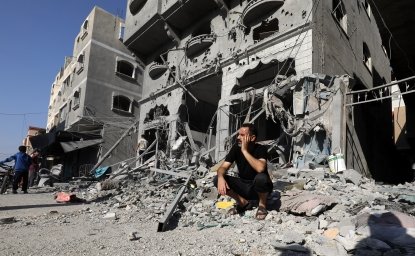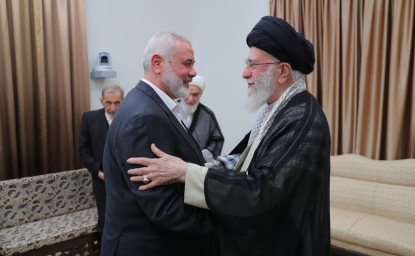The Islamic State strengthened its position in northern Syria after the withdrawal of U.S. troops and subsequent Turkish incursion in October 2019, according to a new quarterly report on Operation Inherent Resolve. The Pentagon’s inspector general outlined how the retreat of Syrian Democratic Forces (SDF), “the United States’ most reliable partner in Syria,” and introduction of Syrian and Russian forces into the area hampered efforts to keep ISIS at bay. The chaotic situation allowed ISIS to “reconstitute capabilities and resources within Syria and strengthen its ability to plan attacks abroad,” according to the Defense Intelligence Agency (DIA). The DIA warned that both Syrian regime forces and Turkish-backed Syrian militias were unlikely to conduct meaningful operations against ISIS. But the SDF committed to continue fighting ISS “as capabilities and authorities allow, from inside Syria or elsewhere.”
In Iraq, ISIS also continued to rebuild, but it struggled to synchronize efforts or acquire terrain. The group was unable to carry out large-scale attacks in areas were the Global Coalition to Defeat ISIS was operating. “ISIS combat power remains in restricted terrain and unpopulated areas where there is little to no local security presence,” according to the Combined Joint Task Force – Operation Resolve (CJTF-OIR). The following are excerpts from the report.
ISIS EXPLOITS TURKISH INCURSION AND DRAWDOWN OF U.S. FORCES
The DIA reported to the DoD OIG that, according to open sources, ISIS exploited the Turkish incursion and subsequent drawdown of U.S. troops to reconstitute capabilities and resources within Syria and strengthen its ability to plan attacks abroad. The DIA also reported that without counterterrorism pressure, ISIS will probably be able to more freely build clandestine networks and will attempt to free ISIS members detained in SDF-run prisons and family members living in internally displaced persons (IDPs) camps. Additionally, according to the DIA, ISIS will likely have the “time and space” to target the West and provide support to its 19 global branches and networks. In the longer term, ISIS will probably seek to regain control of some Syrian population centers and expand its global footprint, the DIA said.
The DIA also reported that the death of ISIS leader Abu Bakr al-Baghdadi, who was killed during a raid conducted by U.S. special operations forces in Syria on October 26, 2019, would likely have little effect on ISIS’s ability to reconstitute. The DIA reported to the DoD OIG that, in its assessment, ISIS is “postured to withstand” al-Baghdadi’s death, and probably will maintain “continuity of operations, global cohesion, and at least its current trajectory.” Open-source analysis also stated that al-Baghdadi’s death was a significant blow to ISIS but would not likely end the ISIS threat.
Prior to the Turkish incursion and U.S. troop withdrawal, USCENTCOM reported that ISIS clandestine cells had been continuing to reconstitute networks and carry out frequent attacks on the SDF and local government officials, particularly in Dayr az Zawr province. This is the same province where the Administration said it was considering sending U.S. troops to help the SDF secure oil fields. The CJTF-OIR reported that the province will likely remain an “area of interest” to ISIS due in part to its central geographic location that allows ISIS to dispatch fighters into Iraq.
SDF COMMITS TO CONTINUE OPERATIONS AGAINST ISIS
OUSD(P)/ISA reported to the DoD OIG on October 25 that U.S. forces will continue to conduct operations against ISIS in Syria “as capabilities and authorities allow, from inside Syria or elsewhere.” According to congressional testimony from Ambassador Jeffrey, the SDF commander, General Mazloum Abdi, committed to continue working with U.S. forces against ISIS. However, as of the completion of this report in mid-November, it was unclear how many of the roughly 100,000 SDF forces were still conducting counter-ISIS operations in northeastern Syria.
Prior to the Turkish incursion and the ensuing temporary pause in SDF operations against ISIS, CJTF-OIR reported to the DoD OIG that the SDF had conducted counter-insurgency raids and clearance operations against ISIS in several provinces in northeastern Syria. During the quarter, which ended September 30, 2019, the SDF had participated in more than 50 partnered operations, detaining more than 200 ISIS fighters and affiliates and seizing small arms, improvised explosive devices (IEDs) and IED-making materials, and documents. In October, according to OUSD(P)/ISA, the SDF “temporarily paused” operations against ISIS as YPG fighters moved north to confront the Turkish incursion.
DIA: OTHER FORCES UNLIKELY TO PRIORITIZE FIGHT AGAINST ISIS
The DIA reported to the DoD OIG that other forces that have moved in northeastern Syria are unlikely to prioritize fighting ISIS. The DIA said that pro-regime forces had not conducted operations against ISIS in the areas that they had moved into, and that these forces probably prioritize limiting Turkey’s incursion into Syria over counterterrorism operations against ISIS. The DIA said that although Syrian regime forces regularly clash with ISIS, the Syrian regime forces probably do not have the will to carry out meaningful operations against ISIS, and will probably also give priority to reclaiming territory from Turkey over operations against ISIS.
Similarly, citing western think tank reports, the DIA reported that Turkish-backed Syrian militias also had not carried out any counterterrorism operations against ISIS since the Turkish incursion in October and were unlikely to do so. The DIA said that some militias backed by Turkey previously helped to smuggle ISIS fighters across borders and probably maintain low-level tactical ties to ISIS. The DIA said that these militias primarily focus on fighting the Syrian regime and the SDF, which they view as terrorists aligned with insurgents in Turkey. In addition, the DIA said that Russian public statements have not focused on plans to counter possible ISIS threats in Syria.
The DoS told the DoS OIG that the areas in which regime and pro-regime forces had advanced were largely free of significant ISIS presence due to counterterrorism pressure on ISIS from the SDF.
TURKISH INCURSION RESULTS IN ISIS PRISON ESCAPES AND CREATES INSTABILITY IN IDP CAMPS
CJTF-OIR said that, as of October 24, likely fewer than 200 ISIS prisoners had escaped from SDF-run prisons that were holding approximately 10,000 in the wake of Turkey’s incursion into northeast Syria. The DIA reported to the DoD OIG that, according to media reports, despite the escapes, the SDF intended to maintain control of the ISIS detention centers in northeast Syria, albeit with fewer prison guards. The DoS reported that two high-profile ISIS detainees held in SDF-run prisons were moved to Iraq.
However, the SDF has warned that it could not indefinitely hold thousands of ISIS prisoners in detention centers across northeast Syria. CJTF-OIR reported that the SDF are entirely reliant on U.S. and Coalition support to fund ISIS detention operations. Both the SDF and the United States had been urging countries to repatriate and prosecute their citizens as a way to reduce the burden on the SDF of holding so many detainees. So far, most countries have been reluctant to repatriate their citizens. At least eight countries, including the United States, have publicly acknowledged repatriating ISIS suspects in SDF custody, the DIA reported. The DoS reported that many countries that have repatriated ISIS fighters from Syria have requested not to be publicly identified.
According to news reports and humanitarian aid organizations, when Turkey crossed into Syria, thousands of residents and humanitarian aid providers fled Ayn Issa, an IDP camp housing approximately 13,000 people near the border. News reports also stated that more than 800 foreign individuals thought to have ties to ISIS, including women and children, may have been among those who fled. The DoS reported that the incursion also forced the evacuation of residents of the Mabrouka IDP camp in Hasakah province. The U.S. Agency for International Development (USAID) reported that both camps were evacuated due to nearby hostilities and the families there were either relocated to nearby camps or fled further south.
According to OUSD(P)/ISA, as of October 24, the SDF continued to provide security at Al Hol, a large IDP camp south of Ayn Issa, but in “a more limited fashion” since the Turkish incursion into Syria. However, OUSD(P)/ISA said that ISIS supporters in the camp could exploit the decreased security posture, but said that it has limited knowledge of the camp because there are no U.S. forces stationed there. According to USAID’s Office of Foreign Disaster Assistance (OFDA), which funds aid agencies working in Al Hol, security at the camp has remained relatively stable since the Turkish incursion into Syria.
EVENTS IN IRAQ
ISIS CONTINUES TO REBUILD, BUT STRUGGLES TO SYNCHRONIZE EFFORTS OR ACQUIRE TERRAIN
OUSD(P)/ISA told the DoD OIG that the drawdown of U.S. forces in Syria did not result in changes to the OIR mission in Iraq, or to ISIS’s activity in Iraq. It reported that the Coalition remains committed to partnering with Iraqi Security Forces (ISF) units against ISIS and bolstering their capacity to eventually suppress ISIS on their own.
CJTF-OIR reported that ISIS continued this quarter to solidify and expand its command and control structure in Iraq, although it had not increased its capabilities in areas where the Coalition was actively conducting operations against ISIS. CJTF-OIR also reported to the DoD OIG that ISIS combat power remains in restricted terrain and unpopulated areas where there is little to no local security presence. USCENTCOM said that ISIS attacks are designed to destabilize the security environment and embarrass the Iraqi government. CJTF-OIR reported that ISIS’s long-term focus remains the reestablishment of a “caliphate.” Despite this activity, CJTF-OIR said that ISIS in Iraq remains decentralized and struggles to synchronize efforts, acquire terrain, and garner public support. CJTF-OIR also said that ISIS is unable to carry out large-scale attacks and maintains minimal forces in areas of Iraq where the Coalition operates.
ISF CANNOT HOLD TERRITORY IN ISIS SUPPORT ZONES
CJTF-OIR stated that a reduction in significant ISIS attacks this quarter demonstrated the tangible results of ISF clearance operations against ISIS. However, according to CJTF-OIR, the ISF does not have a large enough force to control large desert areas. The ISF has also been unable to retain control of territory cleared of ISIS in Salah ad Din province, and has limited access to ISIS support zones in both Salah ad Din and Diyala provinces. The ISF remains “largely unwilling or incapable of holding terrain in the mountains and central and southern wadis of Kirkuk province,” CJTF-OIR said. CJTF-OIR reported that the ministerial staff and headquarters of the Iraqi Counter Terrorism Service (CTS), Iraq’s elite U.S.-trained special operations force, had “dramatically improved” its ability to conduct counterterrorism operations against ISIS. CJTF-OIR also stated that the CTS continued to conduct unilateral operations, including arrests, warrant searches, and collection gathering. However, the ISF continues to lack key capabilities required to fight ISIS.
For instance, the ISF generally continues to lack “operational reach” into less populated areas and its ability to “find and fix” a target is “a major shortfall” in capabilities, CJTFOIR said. It also said that the ISF exploitation capability is “virtually non-existent” without Coalition assistance. CJTF-OIR said that most commands within the ISF will not conduct operations to clear ISIS insurgents in mountainous and desert terrain without Coalition air cover, intelligence, surveillance, and reconnaissance (ISR), and coordination. Despite ongoing training, CJTF-OIR said that the ISF has not changed its level of reliance on Coalition forces for the last 9 months and that Iraqi commanders continue to request Coalition assets instead of utilizing their own systems.
TENSIONS WITH IRAN AND SUSPECTED ISRAELI AIRSTRIKES COMPLICATE OIR IN IRAQ
According to media reports, suspected Israeli airstrikes on Iranian-aligned militia bases in Iraq in July and August elicited a rebuke from Iraqi parliamentarians and resulted in Iraqi government-imposed air restrictions on all foreign aircraft flying over Iraqi airspace, including Coalition aircraft. Media reports stated that as many as four airstrikes targeted bases in Iraq belonging to Popular Mobilization Forces (PMF) militias aligned with Iran. CJTF-OIR reported that the restrictions had “negative effects on air enterprise D-ISIS mission support,” and that the impacts included “reduced observation and monitoring time by ISR assets.” The DoS reported that the air restrictions hurt the Coalition’s ability to counter the ISIS threat in Iraq by reducing the ability of the Coalition to use ISR assets to observe and monitor ISIS activity.
On July 1, 2019, Iraqi Prime Minster Adel Abd al Mahdi issued another government decree ordering the full integration of PMF units into the ISF. According to the DIA, some PMF brigades followed the decree by shutting down headquarters and turning in weapons, but several Iranian-aligned groups refused to comply. In an assessment provided to the DoD OIG, the DIA said that Iranian-affiliated groups within the PMF are unlikely to change their loyalties because of the new order.
Click here for the full report.

The Islamists
Learn more about Hamas and how it relates to similarly aligned organizations throughout the region. Read more

Explore More
Browse Insights & Analysis
Israel Escalates Attacks in Gaza: What’s Next?

Israel Expands Operations on Multiple Fronts: Perspectives on the Conflict

